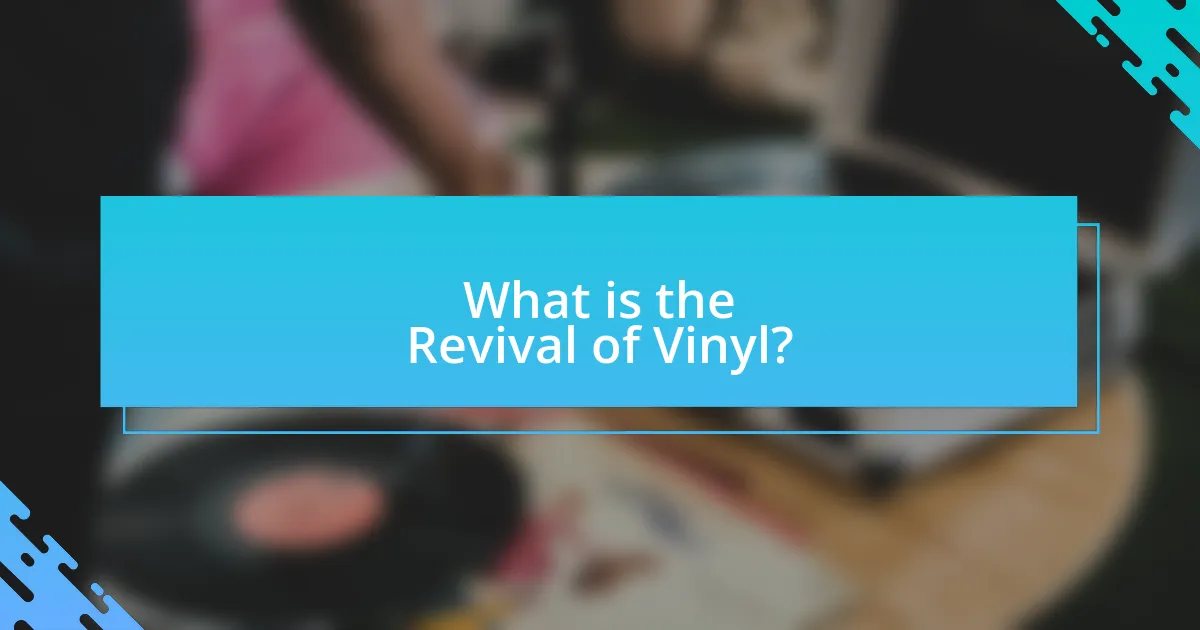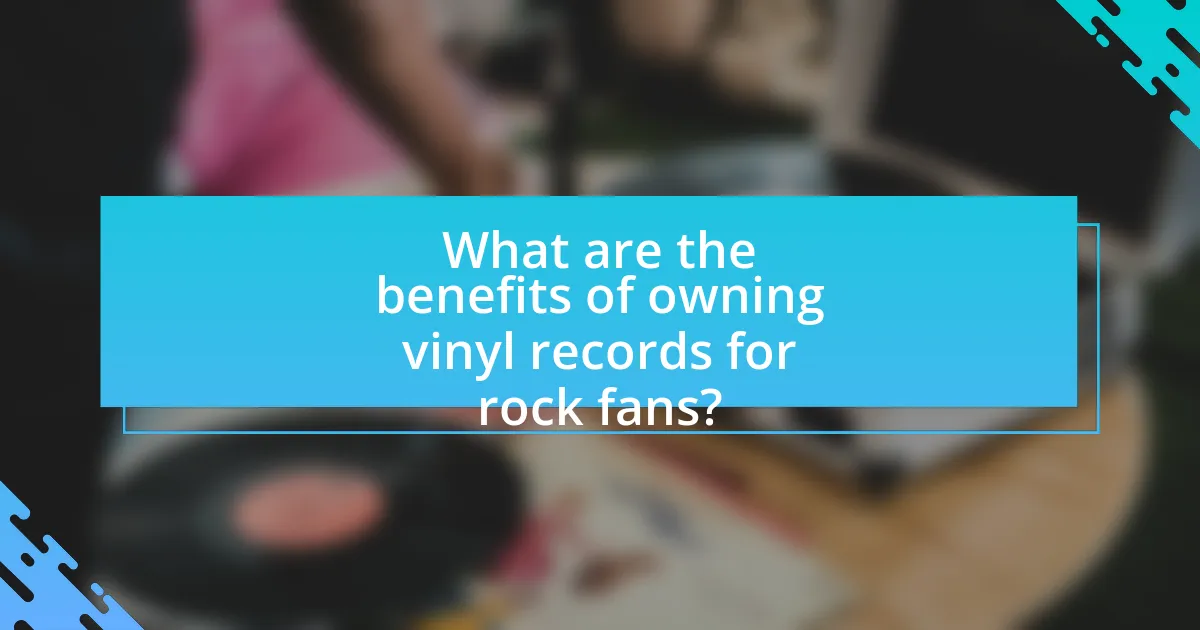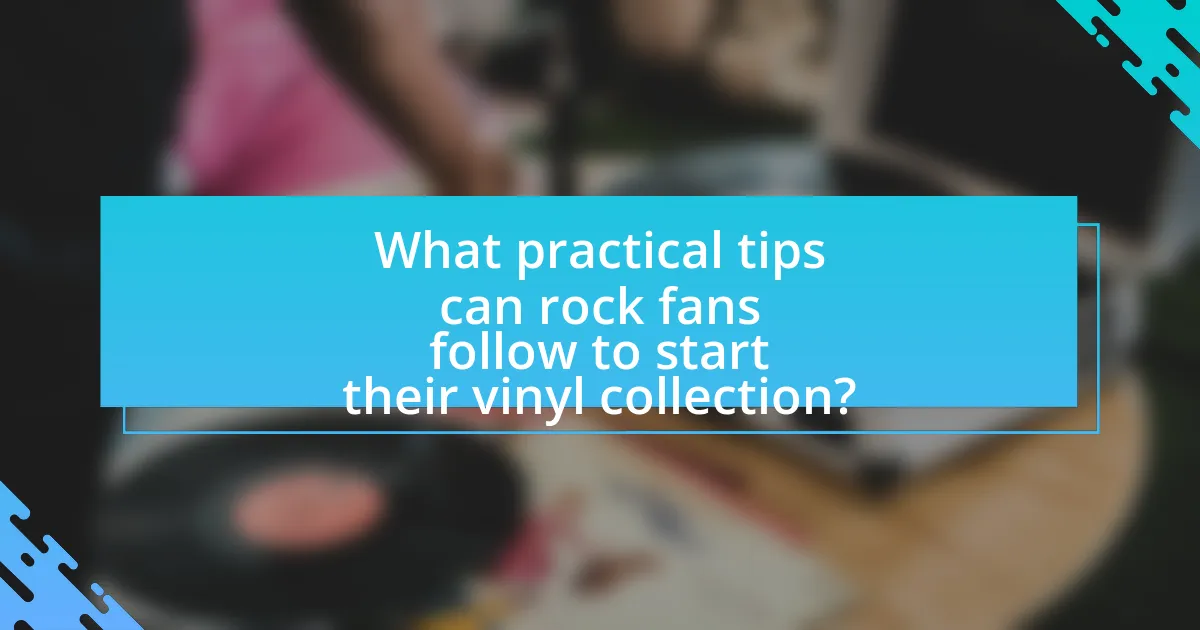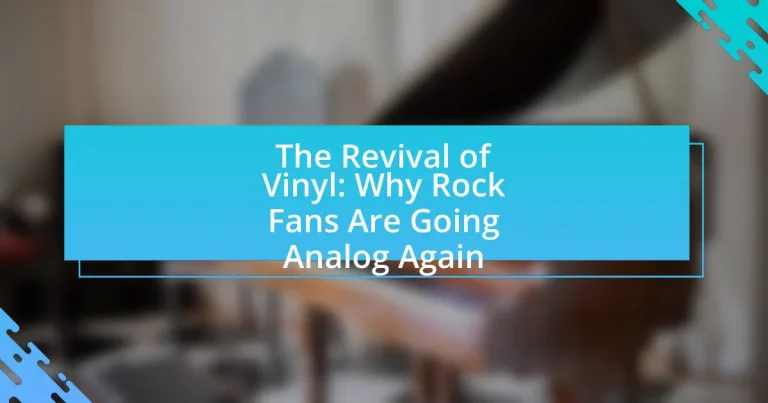The article examines the revival of vinyl records, particularly among rock fans, highlighting the significant increase in vinyl sales, which surpassed CD sales for the first time since the 1980s. It explores the reasons behind this resurgence, including the superior sound quality, tactile experience, and aesthetic appeal of vinyl, as well as the emotional connections and nostalgia it evokes. The article also discusses historical factors that led to the decline of vinyl, the changing perceptions of the format, and the cultural significance it holds today. Additionally, it addresses the challenges facing the vinyl market and offers practical tips for new collectors on building their vinyl collections.

What is the Revival of Vinyl?
The Revival of Vinyl refers to the resurgence in popularity of vinyl records among music enthusiasts, particularly in the rock genre. This trend has been marked by a significant increase in vinyl sales, which reached 41 million units in the United States in 2022, surpassing CD sales for the first time since the 1980s. The revival is driven by factors such as the tactile experience of vinyl, the aesthetic appeal of album artwork, and the perceived superior sound quality compared to digital formats. Additionally, many artists are releasing new music on vinyl, further fueling consumer interest and engagement with this analog medium.
Why has vinyl seen a resurgence in popularity among rock fans?
Vinyl has seen a resurgence in popularity among rock fans primarily due to its perceived superior sound quality and the tangible, nostalgic experience it offers. Rock fans appreciate the warmth and depth of analog sound, which many believe digital formats cannot replicate. According to the Recording Industry Association of America (RIAA), vinyl sales reached a 30-year high in 2020, with over 27 million records sold, indicating a strong consumer preference for this format. Additionally, the physicality of vinyl records, including large album artwork and the ritual of playing a record, enhances the overall listening experience, making it more engaging for fans.
What historical factors contributed to the decline of vinyl before its revival?
The decline of vinyl was primarily driven by the advent of digital music formats and the rise of cassette tapes and CDs in the late 20th century. As technology advanced, the convenience and portability of these new formats led to a significant decrease in vinyl sales; for instance, by the mid-1990s, vinyl records accounted for less than 1% of music sales in the United States. Additionally, the music industry shifted its focus towards producing music in formats that were easier to distribute and consume, further marginalizing vinyl. This transition was marked by the introduction of MP3s in the early 2000s, which revolutionized music consumption and contributed to the near extinction of vinyl records in mainstream markets.
How has the perception of vinyl changed in recent years?
The perception of vinyl has shifted from being viewed as outdated to being celebrated as a premium format for music enjoyment. In recent years, sales of vinyl records have surged, with the Recording Industry Association of America reporting that vinyl sales reached 41 million units in 2020, the highest level since the 1980s. This resurgence is driven by a growing appreciation for the tactile experience and sound quality associated with vinyl, as well as its aesthetic appeal in an increasingly digital world. Additionally, younger generations are embracing vinyl, contributing to its status as a cultural artifact and a symbol of authenticity in music consumption.
What are the characteristics of vinyl records that appeal to rock fans?
Vinyl records appeal to rock fans primarily due to their superior sound quality and tactile experience. The analog format of vinyl captures a wider dynamic range and provides a warmer sound, which many enthusiasts believe enhances the listening experience compared to digital formats. Additionally, the large album artwork and physical presence of vinyl create a more immersive and engaging experience, allowing fans to connect more deeply with the music and the artist. The nostalgia associated with vinyl, particularly in rock music, also plays a significant role; many fans appreciate the historical context and cultural significance of vinyl records in the rock genre, as they were the primary medium for music distribution during the peak of rock’s popularity in the 1960s and 1970s.
How does the sound quality of vinyl compare to digital formats?
Vinyl sound quality is often perceived as warmer and more authentic compared to digital formats. This perception arises from the analog nature of vinyl, which captures sound waves in a continuous form, allowing for a richer harmonic content. In contrast, digital formats use sampling, which can lead to a loss of certain audio details, particularly in lower-quality files. Studies, such as those conducted by the Audio Engineering Society, indicate that vinyl can reproduce a wider dynamic range and more nuanced sound, appealing to audiophiles who value these characteristics.
What role does album artwork play in the vinyl experience?
Album artwork plays a crucial role in the vinyl experience by enhancing the aesthetic and emotional connection to the music. The large format of vinyl records allows for intricate and visually impactful designs that can convey the artist’s vision, themes, and mood of the album. Research indicates that album covers can significantly influence consumer perception and engagement, with studies showing that visually appealing artwork can enhance the listener’s enjoyment and interpretation of the music. For instance, a study published in the Journal of Consumer Research found that consumers often associate high-quality album artwork with higher quality music, reinforcing the importance of visual elements in the overall vinyl experience.
What cultural factors are driving the revival of vinyl among rock enthusiasts?
The revival of vinyl among rock enthusiasts is primarily driven by a cultural appreciation for authenticity and nostalgia. This demographic values the tactile experience of handling records, which contrasts sharply with the digital consumption of music. Additionally, the resurgence of vinyl is fueled by a desire for a more immersive listening experience, as many rock fans believe that vinyl offers superior sound quality compared to digital formats. According to a 2022 report by the Recording Industry Association of America, vinyl sales reached a 30-year high, indicating a significant cultural shift back to analog formats. This trend is also supported by the growing number of vinyl pressing plants and record stores, which cater specifically to the rock genre, further solidifying the cultural significance of vinyl in this community.
How does nostalgia influence the preference for vinyl records?
Nostalgia significantly influences the preference for vinyl records by evoking emotional connections to past experiences and cultural moments. This emotional resonance is often linked to the tactile nature of vinyl, which contrasts with digital formats, creating a sense of authenticity and warmth that many listeners associate with their formative years. Research indicates that nostalgia can enhance the enjoyment of music, as evidenced by a study published in the journal “Psychology of Music,” which found that nostalgic music can trigger positive emotions and memories, reinforcing the appeal of vinyl among those who grew up during the peak of its popularity in the 20th century.
What impact do social media and online communities have on vinyl culture?
Social media and online communities significantly enhance vinyl culture by facilitating connections among enthusiasts and promoting the sharing of music-related content. These platforms allow users to discover new artists, share album reviews, and participate in discussions about vinyl records, which fosters a sense of community. For instance, the rise of Instagram and Facebook groups dedicated to vinyl collecting has led to increased visibility for independent artists and labels, contributing to a resurgence in vinyl sales, which reached 41 million units in the U.S. in 2022, according to the Recording Industry Association of America. This interconnectedness not only supports the vinyl market but also cultivates a culture of appreciation and nostalgia among collectors and new listeners alike.
How does the revival of vinyl connect to broader trends in music consumption?
The revival of vinyl connects to broader trends in music consumption by reflecting a growing consumer preference for physical media and nostalgia in an increasingly digital landscape. This trend is evidenced by the fact that vinyl sales reached 41 million units in 2020, the highest level since 1986, according to the Recording Industry Association of America (RIAA). Additionally, the resurgence of vinyl is part of a larger movement where listeners seek tangible experiences and emotional connections with music, contrasting with the ephemeral nature of streaming services. This shift indicates a desire for authenticity and a deeper appreciation for album artwork and sound quality, which vinyl uniquely provides.
What challenges does the vinyl revival face in the modern music industry?
The vinyl revival faces significant challenges in the modern music industry, primarily due to production limitations and market saturation. The resurgence in vinyl popularity has led to increased demand, but pressing plants often struggle to keep up, resulting in long wait times for new releases. For instance, in 2021, the vinyl industry saw a 50% increase in sales, yet many pressing plants reported backlogs of several months. Additionally, the market is becoming saturated with reissues and limited editions, which can dilute the uniqueness of vinyl releases and lead to consumer fatigue. These factors hinder the sustainability of the vinyl revival amidst a rapidly evolving digital landscape.

What are the benefits of owning vinyl records for rock fans?
Owning vinyl records offers rock fans a unique auditory experience characterized by warmth and depth that digital formats often lack. The analog sound reproduction of vinyl captures the nuances of music, providing a richer listening experience that many enthusiasts prefer. Additionally, vinyl records often feature larger album artwork, enhancing the visual aspect of music consumption, which is particularly appealing for rock fans who appreciate album art as part of the overall experience. Furthermore, the tactile nature of handling vinyl records fosters a deeper connection to the music, making the act of listening more intentional and immersive. Studies have shown that vinyl sales have surged, with a reported increase of 29% in 2020 alone, indicating a strong resurgence in interest among music lovers, particularly in genres like rock.
How does collecting vinyl enhance the music listening experience?
Collecting vinyl enhances the music listening experience by providing a tangible and immersive connection to the music. Vinyl records offer a unique sound quality characterized by warmth and depth, which many audiophiles prefer over digital formats. The physical act of handling records, including the ritual of placing a needle on the vinyl, creates a more engaged listening experience. Additionally, album artwork and packaging contribute to the overall aesthetic appreciation of music, allowing collectors to enjoy visual elements alongside auditory ones. Research indicates that the tactile nature of vinyl can evoke stronger emotional responses, enhancing the listener’s connection to the music.
What are the emotional and psychological benefits of vinyl ownership?
Vinyl ownership provides significant emotional and psychological benefits, including enhanced nostalgia, a sense of connection, and improved mindfulness. The tactile experience of handling records and the ritual of playing them evoke memories and emotions tied to specific moments, fostering a deep sense of nostalgia. Additionally, the physicality of vinyl creates a tangible connection to music, allowing listeners to engage more fully with the art form. Research indicates that engaging with music through physical formats can enhance emotional well-being, as it encourages active listening and mindfulness, reducing stress and promoting relaxation. A study published in the Journal of Positive Psychology found that music engagement, including vinyl listening, is linked to increased happiness and life satisfaction.
How does vinyl collecting foster a sense of community among fans?
Vinyl collecting fosters a sense of community among fans by creating shared experiences and facilitating social interactions. Collectors often engage in discussions about their favorite albums, attend record fairs, and participate in online forums, which strengthens their connections. For instance, events like Record Store Day bring enthusiasts together, allowing them to celebrate their passion collectively. Additionally, the tactile nature of vinyl encourages collectors to share their finds and recommendations, further enhancing communal bonds. This social aspect is supported by research from the Journal of Consumer Research, which indicates that shared hobbies can significantly enhance social ties among individuals.
What are the financial implications of investing in vinyl records?
Investing in vinyl records can yield significant financial implications, primarily due to their increasing market value and collector demand. The vinyl record market has seen a resurgence, with sales reaching over 41 million units in the U.S. in 2022, marking the highest level since 1987, according to the Recording Industry Association of America (RIAA). This trend indicates a growing appreciation for vinyl among consumers, which can lead to potential appreciation in value for rare or limited-edition records. Additionally, certain albums can appreciate significantly over time; for instance, original pressings of iconic albums can sell for thousands of dollars at auction. Therefore, investing in vinyl records not only serves as a nostalgic hobby but also presents opportunities for financial gain through appreciation and resale.
How does the value of vinyl records appreciate over time?
The value of vinyl records appreciates over time primarily due to increased demand among collectors and music enthusiasts, coupled with the limited supply of certain editions. As vinyl records have experienced a resurgence in popularity since the early 2000s, particularly among younger generations, the market for rare and vintage records has expanded significantly. For instance, according to the Recording Industry Association of America, vinyl sales reached a record high of over 41 million units in 2020, indicating a growing interest that drives up prices for sought-after albums. Additionally, factors such as the condition of the record, rarity, and historical significance contribute to the appreciation of value, with certain records selling for thousands of dollars at auctions.
What should collectors consider when purchasing vinyl records?
Collectors should consider the condition, rarity, and pressing details of vinyl records when making a purchase. The condition directly affects the sound quality and value; records graded as “Mint” or “Near Mint” are typically more desirable. Rarity plays a significant role in a record’s worth, with limited editions or first pressings often commanding higher prices. Additionally, understanding the pressing details, such as whether the record is an original release or a reissue, can influence both the collectibility and the listening experience. For instance, original pressings from the 1960s and 1970s are often sought after due to their historical significance and sound quality.

What practical tips can rock fans follow to start their vinyl collection?
Rock fans can start their vinyl collection by first determining their budget and setting a clear goal for the types of records they want to acquire. Establishing a budget helps prioritize purchases, while focusing on specific genres or artists can streamline the selection process.
Next, fans should seek out local record stores, which often have a curated selection of vinyl, and can provide valuable insights into the best pressings and editions. Additionally, attending record fairs and online marketplaces can expand options and offer rare finds.
Finally, investing in a quality turntable and speakers is essential for optimal sound quality, as the listening experience is a key aspect of vinyl collecting. According to a 2021 report by the Recording Industry Association of America, vinyl sales reached a 30-year high, indicating a growing interest in analog formats among music enthusiasts.
How can beginners choose their first vinyl records?
Beginners can choose their first vinyl records by identifying their musical preferences and exploring classic albums that have influenced the genre they enjoy. Starting with iconic records, such as The Beatles’ “Abbey Road” or Pink Floyd’s “The Dark Side of the Moon,” provides a solid foundation, as these albums are widely regarded for their quality and historical significance in rock music. Additionally, visiting local record stores allows beginners to discover curated selections and receive recommendations from knowledgeable staff, enhancing their understanding of vinyl culture. This approach not only helps in selecting records that resonate personally but also fosters a deeper appreciation for the analog format, which has seen a resurgence in popularity, with vinyl sales reaching over 41 million units in 2020, according to the Recording Industry Association of America.
What are the best places to buy vinyl records?
The best places to buy vinyl records include independent record stores, online retailers like Discogs and Amazon, and specialty shops that focus on vinyl. Independent record stores often provide a curated selection and knowledgeable staff, enhancing the shopping experience. Discogs, a marketplace for music collectors, offers a vast inventory from various sellers, making it easy to find rare and new releases. Amazon provides convenience and a wide range of options, including new and used records. Specialty shops, such as those focusing on specific genres or local artists, can offer unique finds that appeal to niche audiences.
How should vinyl records be cared for and maintained?
Vinyl records should be cared for and maintained by cleaning them regularly, storing them vertically, and handling them by the edges. Regular cleaning with a carbon fiber brush or a dedicated vinyl cleaning solution removes dust and debris, which can cause scratches and affect sound quality. Storing records vertically prevents warping and damage, while handling them by the edges minimizes the transfer of oils and dirt from fingers. According to the Vinyl Record Preservation Society, proper care can extend the lifespan of vinyl records significantly, ensuring optimal playback quality.
What are common mistakes to avoid when starting a vinyl collection?
Common mistakes to avoid when starting a vinyl collection include not researching the condition of records, neglecting to invest in proper storage, and overlooking the importance of a quality turntable. Many new collectors purchase records without checking for scratches or warps, which can significantly affect sound quality. Additionally, improper storage can lead to warping or damage; records should be stored vertically and away from direct sunlight. Lastly, using a low-quality turntable can diminish the listening experience, as the equipment plays a crucial role in sound reproduction. These mistakes can hinder the enjoyment and longevity of a vinyl collection.
How can collectors avoid counterfeit records?
Collectors can avoid counterfeit records by verifying the authenticity of the vinyl through several methods. First, they should examine the record’s label and matrix numbers, as genuine records often have specific identifiers that can be cross-referenced with official discographies. Additionally, collectors should inspect the quality of the vinyl itself; authentic records typically have a heavier weight and a glossy finish, while counterfeits may feel lighter and have a dull appearance.
Furthermore, purchasing from reputable dealers or established online platforms with return policies can significantly reduce the risk of acquiring counterfeit items. According to a study by the International Federation of the Phonographic Industry, around 30% of vinyl records sold online are counterfeit, highlighting the importance of diligence in sourcing. Collectors should also familiarize themselves with the specific characteristics of the records they are interested in, including packaging details and artwork, as these can provide clues to authenticity.
What should fans know about record players and equipment?
Fans should know that record players, also known as turntables, are essential for playing vinyl records, which have seen a resurgence in popularity among music enthusiasts. Key components of record players include the platter, tonearm, cartridge, and stylus, each playing a crucial role in sound quality. For instance, the stylus, or needle, directly contacts the vinyl grooves, translating physical vibrations into audio signals. Additionally, fans should be aware that the quality of the equipment, including the turntable’s build and the speakers used, significantly impacts the listening experience. Research indicates that vinyl sales have increased for over a decade, with the Recording Industry Association of America reporting that vinyl sales surpassed CD sales in 2020, highlighting the growing interest in analog sound.
















